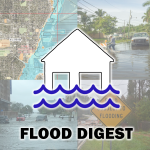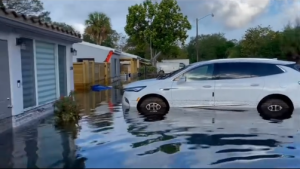Plus, Florida’s comprehensive flood assessment plan
 Ft. Lauderdale considers raising roadways as a last-ditch effort to alleviate chronic flooding, a new “Flood Hub” will soon assess flood vulnerability for every piece of vital infrastructure in Florida, and there’s a new federal rule requiring publicly-traded corporations report the costs of flooding, sea level rise, and their own emissions. It’s all in this week’s Flood Digest.
Ft. Lauderdale considers raising roadways as a last-ditch effort to alleviate chronic flooding, a new “Flood Hub” will soon assess flood vulnerability for every piece of vital infrastructure in Florida, and there’s a new federal rule requiring publicly-traded corporations report the costs of flooding, sea level rise, and their own emissions. It’s all in this week’s Flood Digest.

Flood waters remained to the bottom of car doors and nearly to front door knobs of homes in Ft. Lauderdale the morning after the big rain, April 13, 2023. Courtesy, Broward S.O.
Ft. Lauderdale Takes the High Road: As we’ve previously reported in this newsletter, Ft. Lauderdale has a flooding problem. Low-lying neighborhoods across the city have seen extensive water damage from flash floods and storms in recent years even with measures like seawalls and better pumping stations put into place. For many city officials, raising the roads in the city to prevent roadway flooding seems to be the only option left, but they have asked for input from experts with the Urban Land Institute (ULI), a non-profit organization that has helped other flood-prone cities. A ULI panel will report back to Ft. Lauderdale in the coming months with an assessment and recommendations on which roads, and how high to raise them. But raising the roads means the floodwater could run off into yards and homes, which has happened in Miami Beach, on a similar project. Ft. Lauderdale officials are hesitant to raise roads for these reasons, calling it a “last resort” and have encouraged homeowners to retreat from the coast or build their own seawalls to try to mitigate flood damage. You can read more in this Sun-Sentinel article.

Florida Chief Resiliency Officer Wes Brooks addresses the Gulf of Mexico Alliance Conference, February 20, 2024. Courtesy, WUSF-FM
USF’s Flood Hub: Mitigation starts with assessing current risks. Thanks to the new “Florida Flood Hub” established at the USF College of Marine Science in St. Petersburg, a comprehensive assessment of flood vulnerability on critical infrastructure statewide will soon begin. Wes Brooks, Florida’s Chief Resilience Officer, spoke last month at the annual Gulf of Mexico Alliance Conference in Tampa and said the hub would act as a repository for flood models and identify vulnerable assets to paint a clear picture of flood risk. “I believe that Florida will be the first state in the country and certainly the largest for some time, I would suspect, to have assessed the flood vulnerability of virtually every single piece of infrastructure and critical asset that there is with the state’s borders,” Brooks said. More than 230 planning grants have been awarded to cities and counties statewide to help ease the technical burden and assist municipal planning to mitigate future flood damage.
 Flood & Emission Rule: The U.S. Securities and Exchange Commission (SEC) earlier this month approved a final rule requiring that climate risk be included in the financial and registration statements of publicly traded companies. The rule requires the reporting of Scope 1 and Scope 2 emissions (a company’s own emissions and emissions from all purchased utilities, respectively), but not Scope 3 (greenhouse gas emissions), which was included in the initial proposal. The rule also requires disclosure of costs, expenditures, and losses incurred in severe weather events, including flooding and sea level rise. More information can be found on the SEC’s Factsheet.
Flood & Emission Rule: The U.S. Securities and Exchange Commission (SEC) earlier this month approved a final rule requiring that climate risk be included in the financial and registration statements of publicly traded companies. The rule requires the reporting of Scope 1 and Scope 2 emissions (a company’s own emissions and emissions from all purchased utilities, respectively), but not Scope 3 (greenhouse gas emissions), which was included in the initial proposal. The rule also requires disclosure of costs, expenditures, and losses incurred in severe weather events, including flooding and sea level rise. More information can be found on the SEC’s Factsheet.
LMA Newsletter of 3-25-24

